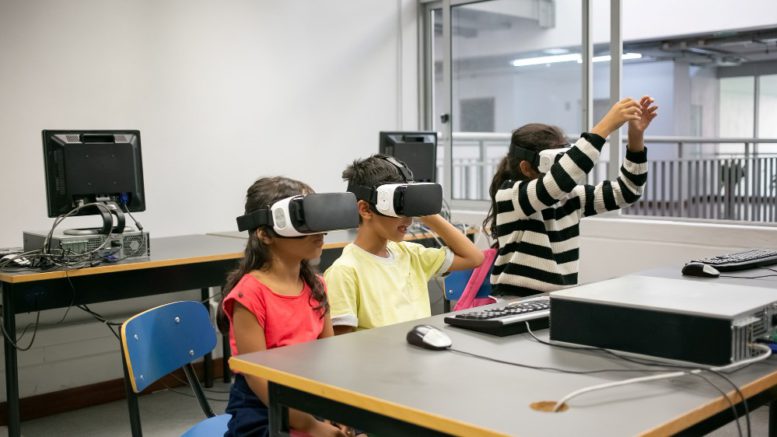With artificial intelligence [AI] growing in importance throughout our lives, Robbie Scarff explores the potential impact of artificial intelligence on education and schools. Robbie has also written a companion piece on the effect of AI on skills and our working lives.
These blogs are produced as background to our event on AI and education with the Goodison Group in Scotland.
Introduction
AI is increasingly being deployed in schools, with proponents arguing it will improve standards in education and, ultimately, help students achieve more.
The number of individual tools AI provides towards this endeavour are plentiful, and their proposed benefits even more so.
Yet will these benefits come at a cost?
Here we look at how and why AI is being used in schools, as well as the issues this raises.
Approach
We asked some teachers if AI was being used in their school, if they thought it could be helpful, and what issues it may raise, and their responses are included throughout. The teachers were from a primary school (Scotland), special needs primary school (Scotland), and a university technical college (UTC) (England).
One teacher’s comment points to the issue of AI’s use in schools occurring rapidly, without a regulatory framework to guide its use: “at the minute there is no clear message that AI is or is not an acceptable tool to use, it’s just landed like an alien in the classroom … so governance must quickly be organised if we are to harness this well”.
How and why is AI being used in schools?
There are many ways AI is being used in schools. The following are just some examples.
Intelligent tutoring systems
AI can be used in learning programs which assess students’ previous knowledge and learning style, provide tailored support, and set personalised assessments.
This can save teachers time and provide students with a learning experience that suits their level of understanding and way of learning.
A UTC teacher viewed this is a real benefit and was glad of the prospect of AI saving them time with numerous “paper tasks which teachers get bogged down in”.
Assistive technology
AI can assist students with special needs, resulting in more equitable access to education.
For example, speech recognition tools can help students who are unable to write, while optical character recognition allows visually impaired students to scan and listen to written material.
Teachers across the board were very much in favour of this use of AI.
One UTC teacher told us that some students simply “prefer interaction digitally, instead of a support worker”.
Emotional AI (EAI)
EAI infers students’ emotions via external signals, such as facial expressions or what they write. It is also used to infer factors such as attentiveness, conscientiousness, and aggression.
The goal of EAI in schools is to identify students who need more help or challenged further, monitor attention, and assess students’ social and emotional learning.
The primary teacher we spoke to expressed ambivalence towards EAI’s usefulness, asking “would this really provide relevant/additional information for teachers that they don’t already recognise themselves in class?”
Interactive games
AI-powered interactive games provide a way for younger students to learn basic academic and social skills in a fun and engaging way.
This can help students build key skills and develop a strong appetite for learning from a young age.
Study guides
Cram101 can turn textbooks into smart study guides complete with practice tests.
This provides students with a concise summary of what they need to know, saving them time, and providing more engaging ways of revising.
Learning analytics
Teachers can use AI to analyse data on student progression. This can be used to provide nuanced feedback and make more informed decisions about how to improve their learning.
One teacher spoke of feeling under pressure to provide progress data to councils or education departments, and they hoped AI may provide a more efficient means to do so. They added that teachers have different methods for recording data at the moment, which have biases and subjectivity, whereas they felt AI is objective – or at least more consistent – allowing for better comparison of each child’s results as they progress.
The primary teacher pointed out that the majority of decisions on improving learning “are based around physical observations of pupils working, completing tasks and interacting with others” and went on to ask, “how would AI get a better picture of this than a teacher?”
In sum, AI in classrooms potentially provides the following benefits:
- Personalised support and assessments
- More equitable access to education
- Monitoring behaviour
- Making learning fun
- Saving teachers and students time
- Providing detailed analysis of students’ progress
It could also provide further benefits, such as:
- Supporting learning at home
- Aligning skills and knowledge with industry demands
- Increasing job readiness
- Generally improving the standard of educational attainment
Issues raised by AI in education
The impacts of AI in education can be considered in two broad categories: those that directly relate to the delivery and quality of education, and those that relate to wider consequences beyond education.
Direct impact on education
The first issue to consider is whether these technologies work as claimed, in other words, are they actually delivering the benefits. EAI provides the clearest example of this problem.
Proponents claim EAI is able to accurately infer emotional states, while an academic review in the journal Psychological Science in the Public Interest has argued strongly that it simply cannot do this.
Therefore, if the technology used to assess students’ emotions, attentiveness etc and categorise them on that basis, with consequences for their education, does not work as claimed, what does this mean for the supposed benefits EAI brings? Not only may the benefits be an illusion, but miscategorising students could also cause them harm.
The lesson here is that, for AI to be used in schools, it must be subject to rigorous testing to prove it can actually do as claimed.
The second issue is that AI may benefit some aspects of education at the expense of others.
For example, Cram101 may be able to synthesise textbooks into study guides, thus saving students time which they could use to study more. Indeed, one UTC teacher said AI could help students “who find the vast wealth of information too much to get through”.
However, being able to discern what’s important from what isn’t when studying is a key skill in itself which may be lost. Two teachers from the UTC were concerned about the impact on student’s development and worried that AI will make them “lazier” and “less able to think on their feet or strategically”.
Regarding intelligent tutoring systems which automatically adjust education delivery based on the student’s performance, while this provides a personalised learning program which benefits the student, they may lose the ability to recognise and communicate what they are struggling with, another key skill.
The lesson here is that AI can provide valuable benefits, but there are inevitably trade-offs that must be recognised and evaluated when implementing AI.
Impacts beyond education
Rights
AI has the potential to violate students’ human rights.
Bias and discrimination
The risk of bias and discrimination blurs the distinction between impacts on education and wider impacts.
AI has been shown to replicate and exacerbate existing biases due to how it is developed. AI may also lead to new forms of discrimination by creating novel ways to treat students differently.
Students’ data may impact their education now, and their life in the future, for example if it is used by potential employers to assess them.
Privacy
If AI systems are used to collect data about children, who are unable to properly assess whether they want such data collected (and possibly retained indefinitely thus affecting their adult lives), there is a risk of their right to privacy being eroded.
Data protection
It is vital to ask who has access to student’s educational data and what they are using that data for. This is especially true for special category data (which is more sensitive and requires greater protection) such as student’s special needs requirements.
Safeguards should be in place to ensure data is only used for its intended purpose, namely, to improve education delivery, and not sold to or used by third parties for profit or other ends.
Freedom of thought
The right to freedom of thought protects students from their thoughts being revealed, manipulated, or used to penalise. This is an area of inquiry in human rights law, and it has been argued we must examine what violations of this right might look like. I have argued elsewhere that EAI may pose a threat to each of the three elements of this right by
- Attempting to reveal children’s thoughts
- Manipulating thoughts by dictating which emotional expressions (and by extension, thoughts) are appropriate, and
- Penalising children for not displaying the “correct” behaviour
It’s important to note that, even if AI cannot accurately determine students’ thoughts, if they believe it can, it may still result in harmful effects.
Function creep
Function creep refers to AI being used for purposes it was not originally intended for.
For example, learning analytics may initially be a useful tool to provide highly personalised, useful feedback to students, but may later be used as a means to assess their suitability for access to further educational opportunities, such as university courses.
Schools and regulators must be wary of, and find ways of preventing, AI systems being deemed acceptable, implemented, and then used for alternative purposes which are unacceptable.
Summary
The benefits AI can provide to education are numerous and valuable. However, the potential risks must also be considered.
Nearly all the teachers we spoke to noted they already have a heavy workload and were concerned that being trained to use AI properly (which they felt is important) and using it in the classroom would simply add more pressures on their already limited time.
A concern shared by two UTC teachers was the impact of AI on coursework and plagiarism. They noted that students are “already playing around with AI and haven’t realised its potential yet” but that it’s “only a matter of time before it’s widespread” and that they hope they are given tools to help them spot plagiarism.
The primary teacher we spoke to made a poignant observation, which raises a key final point to reflect on. They stated that “observations and interactions between teachers and pupils are more realistic, enjoyable and relatable in real life, not through digital programmes” (emphasis added).
Students should enjoy their education, and for that to happen learning must be fun. Everyone remembers that one teacher who not only taught them well but taught them how to enjoy the process of learning. Does the use of AI risk dehumanising and weakening that vital human connection that makes it fun?
Perhaps. Time will tell. For now, here are the key points we consider vital if AI is to support education.
Use of AI in educational settings should be conditional upon:
- It working as intended/claimed
- The risks/downsides being acceptable relative to the benefits
- It supporting, not burdening, teachers
- It only being used for its original intended purpose, and
- It not violating students’ human rights
Robbie Scarff

Robbie Scarff is a freelance copywriter and editor/proof-reader based in Edinburgh. In his spare time he enjoys hillwalking, going to gigs, writing poetry, reading, and watching football. Robbie previously completed an internship with the Futures Forum during which he produced a review of parliamentary responses to artificial intelligence [AI] and a toolkit for scrutinising the use of AI.
Scotland’s Futures Forum exists to encourage debate on Scotland’s long-term future, and we aim to share a range of perspectives. The views expressed in this blog are those of the author and do not necessarily reflect the Futures Forum’s views.

